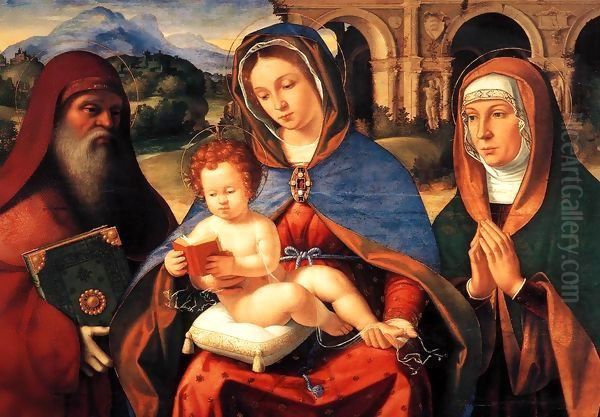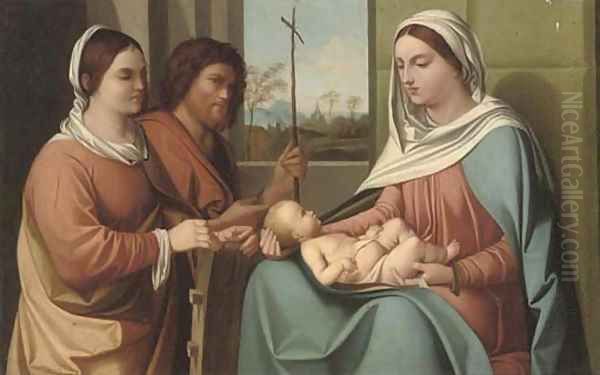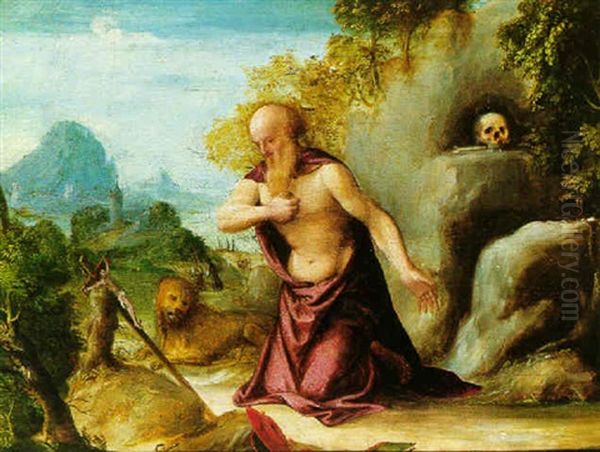Andrea Previtali, also known as Andrea Cordelliaghi or Cordarigi, stands as a significant, if sometimes overlooked, figure in the vibrant tapestry of Italian Renaissance art. Active during the late 15th and early 16th centuries, he skillfully navigated the rich artistic currents of Venice, then the dominant force in Northern Italian painting, and later brought these influences to his native region of Bergamo, creating a unique synthesis that contributed to the distinctive character of the Bergamasque school. His oeuvre, primarily consisting of religious altarpieces and devotional paintings, alongside a number of insightful portraits, reflects a deep understanding of color, light, and human emotion, learned from the masters of his time and adapted with a personal sensitivity.
Origins and Venetian Formation
The precise birthplace of Andrea Previtali has been a subject of some scholarly discussion. While traditionally believed to have been born in Berbenno, a small town in the Imagna Valley near Bergamo, around 1470-1480, some historical records suggest a possible origin in Brembate or a nearby locality. This ambiguity, common for artists of this period where documentation can be scarce or contradictory, does little to diminish the impact of his subsequent career. What is certain is his Lombard heritage, which would later inform the character of his mature works.
Like many ambitious young artists from the Venetian mainland territories (the Terraferma), Previtali was drawn to the magnetic pull of Venice, the bustling artistic and commercial heart of the region. It was here, in the dynamic workshops of the city, that he received his formative training. Crucially, Previtali became associated with the studio of Giovanni Bellini, the leading painter in Venice at the time and a figure of immense influence. Bellini's workshop was a crucible of talent, and Previtali's presence there placed him at the epicenter of Venetian artistic innovation.

Under Bellini's tutelage, Previtali would have absorbed the master's profound sensitivity to color, his mastery of atmospheric light, and his ability to imbue religious figures with a gentle, human pathos. The Bellini workshop was not an isolated entity; it was a place where ideas were exchanged, and where young artists were exposed to the works of other leading figures. Previtali would have been aware of the narrative richness of Vittore Carpaccio, the serene compositions of Cima da Conegliano, and the emerging, poetic style of younger contemporaries like Giorgione and the young Titian, who were also revolutionizing Venetian painting.
Previtali's early works, often signed with variations of "Andrea Bergomensis" (Andrea from Bergamo) or "Andrea Cordeliaghi" (a nickname possibly derived from "cordelle" or strings, perhaps linked to his family's trade, though this is speculative), clearly demonstrate the Bellinesque imprint. These paintings are characterized by their luminous palettes, soft modeling of forms, and tranquil, often pastoral, landscape backgrounds, all hallmarks of his master's style. He learned to construct balanced compositions and to depict figures with a quiet dignity, often set within meticulously rendered natural settings.
The Venetian Period: Developing a Personal Voice
During his Venetian period, which lasted until around 1511-1512, Previtali established himself as a competent and respected painter. He produced numerous Madonnas, Sacre Conversazioni (Holy Conversations, depicting the Virgin and Child with saints), and portraits. While deeply indebted to Giovanni Bellini, Previtali began to subtly assert his own artistic personality. His figures, while retaining Bellinesque grace, sometimes exhibit a slightly more robust quality, perhaps a foreshadowing of the Lombard naturalism that would become more pronounced later in his career.
His handling of landscape, a key feature in Venetian painting, was particularly adept. He often incorporated detailed and atmospheric vistas, demonstrating an appreciation for the beauty of the natural world that went beyond mere backdrop. These landscapes, with their gentle hills, distant mountains, and carefully observed foliage, contribute significantly to the devotional mood of his religious paintings. He also showed an interest in the play of light, not just in its ability to model form, but also in its capacity to create mood and unify a composition.
One notable work that exemplifies his early maturity and Venetian training is the Annunciation, painted around 1508 and now housed in the church of Santa Maria Annunziata del Meschio in Vittorio Veneto (near Treviso). This painting showcases his skill in rendering delicate figures, rich textiles, and a convincing architectural space, all bathed in a soft, unifying light. The composition is harmonious, and the emotional tenor is one of serene reverence, typical of the Bellini school's approach to sacred themes.

His portraiture from this period, though less numerous than his religious works, also reveals his keen observational skills. He captured the likeness of his sitters with a straightforward honesty, often imbuing them with a sense of quiet introspection. These portraits reflect the growing demand for individual likenesses among the Venetian patriciate and merchant classes.
Return to Bergamo: A New Artistic Landscape
Around 1511 or 1512, Andrea Previtali made the significant decision to return to his native Bergamo. The reasons for this move are not definitively known but could have been prompted by a desire to establish himself as a leading master in his home region, away from the intense competition of Venice, or perhaps by family obligations. His return marked a new phase in his career, one where he would become a pivotal figure in the local art scene, acting as a conduit for Venetian artistic ideas while also responding to the specific tastes and traditions of Lombardy.
Bergamo, while politically part of the Venetian Republic, possessed its own distinct cultural and artistic identity. Lombard art, in general, tended towards a greater naturalism and a more direct emotional appeal compared to the often more idealized and poetic art of Venice. Artists like Vincenzo Foppa, a foundational figure of the Lombard school, had established a tradition of robust realism and expressive intensity. Previtali, arriving with his sophisticated Venetian training, was well-positioned to merge these different artistic currents.
Upon his return, Previtali quickly secured important commissions for churches and private patrons in Bergamo and the surrounding towns. His style began to evolve, reflecting his new environment. While the elegance and chromatic richness of his Venetian formation remained, his figures often acquired a greater solidity, and his compositions sometimes displayed a more dynamic energy. He also showed an increasing interest in the works of other contemporary artists active in Lombardy and the Veneto.

A crucial relationship during this Bergamasque period was his friendship and artistic interaction with Lorenzo Lotto. Lotto, an enigmatic and highly individualistic painter who had also spent time in Venice, worked in Bergamo for an extended period (roughly 1513-1525). The two artists were contemporaries and friends, and their artistic paths undoubtedly crossed. Lotto's intense psychological insight, unconventional compositions, and vibrant, sometimes unsettling, color palettes would have offered a stimulating counterpoint to Previtali's more measured Bellinesque style. It is documented that Previtali created an altarpiece for the choir of Santa Maria Maggiore in Bergamo, a church where Lotto was famously engaged in creating the elaborate intarsia designs for the choir stalls. This proximity suggests a period of mutual awareness and potential influence.
Previtali's works from this period often show a deeper emotional resonance and a more pronounced naturalism. He continued to be influenced by Venetian masters, including the later works of Bellini and the rising stars like Titian and Palma il Vecchio. Palma il Vecchio, himself of Bergamasque origin but primarily active in Venice, was known for his opulent female figures and rich, pastoral scenes, and his influence can be discerned in some of Previtali's more sensuous renderings of saints and Madonnas.
Major Works and Thematic Concerns in Bergamo
Previtali's Bergamasque period was highly productive, and he created some of his most significant works during this time. He became a favored painter for local confraternities, churches, and private citizens, fulfilling a demand for altarpieces, devotional panels, and portraits.
Among his most celebrated works from this era is the Saint John the Baptist with Four Saints (also known as the Casotti Altarpiece), painted in 1515 for the church of Santo Spirito in Bergamo. This large-scale altarpiece demonstrates Previtali's mature style, successfully blending Venetian colorism and grace with a Lombard sense of gravity and presence. The figures are noble and expressive, arranged in a harmonious composition that invites contemplation. The landscape background remains important, adding depth and atmosphere to the sacred scene.
Another significant work is Christ Blessing, dating from around 1512-1515. This intimate devotional image depicts Christ with a crystal orb, a symbol of His dominion over the world (Salvator Mundi). The painting is notable for its delicate modeling, the gentle expression of Christ, and the meticulous rendering of details, such as the transparency of the orb. This work highlights Previtali's ability to convey profound spiritual meaning through subtle means.
The Triptych of Saint Sigismund, recorded as being created in 1512 and located in the church of Santa Maria del Capitolino in Bologna, is another important commission, though its specific location and configuration as a triptych in that particular church can be complex to trace definitively in all art historical literature. However, images of Saint Sigismund by Previtali do exist, such as a panel in the Accademia Carrara, Bergamo, indicating his engagement with this saintly figure, who was venerated in various parts of Italy. Such works often featured the saint in regal attire, reflecting his status as a Burgundian king and martyr.
Previtali's religious paintings often explored traditional themes such as the Madonna and Child, the Holy Family, and various saints, but he approached these subjects with a fresh eye and a refined technique. His Madonna and Child with St. John the Baptist and a Female Saint (Mary Magdalene?), now in the National Gallery, London, is a fine example of his ability to create tender and accessible devotional images. The interaction between the figures is natural, and the colors are rich and harmonious. His depiction of the Madonna Baglioni (Accademia Carrara, Bergamo) showcases a more dynamic composition, possibly reflecting the influence of artists like Raphael or Fra Bartolommeo, whose works were becoming known throughout Italy.
He also continued to produce portraits. These works, while perhaps less famous than his religious paintings, are valuable for their psychological insight and their record of the Bergamasque elite. They demonstrate his skill in capturing individual likenesses and conveying the sitter's personality.
Throughout his Bergamasque period, Previtali demonstrated an ability to adapt and respond to various artistic stimuli. While his grounding in Bellini's workshop remained a constant, he was open to the innovations of his contemporaries. The influence of Lombard masters like Bramantino or Bernardino Luini, with their characteristic sweetness and clarity, might also be subtly felt in the gentle demeanor of some of his figures. He successfully carved out a niche for himself, becoming one of the most respected painters in Bergamo.
Artistic Influences and Contemporaries: A Wider Circle
Andrea Previtali's artistic journey was shaped by a constellation of influential figures and a vibrant artistic milieu. His primary mentor, Giovanni Bellini, provided the foundational elements of his style: luminous color, atmospheric perspective, and a gentle, humanized approach to religious subjects. The Bellini workshop itself was a hub, and Previtali would have been aware of Giovanni's brother, Gentile Bellini, known for his large narrative canvases, and Alvise Vivarini, head of a rival workshop that also produced significant religious art.
The impact of Vittore Carpaccio, with his detailed and anecdotal storytelling, and Cima da Conegliano, master of serene altarpieces and tranquil landscapes, was pervasive in Venice during Previtali's formative years. The enigmatic and poetic art of Giorgione, a slightly younger contemporary, was ushering in a new, more lyrical phase of Venetian painting, and its influence, particularly in the treatment of landscape and mood, can be felt.
Upon his return to Bergamo, Lorenzo Lotto became a significant contemporary. Lotto's highly personal and expressive style, his dynamic compositions, and his intense colorism offered a powerful local influence. Previtali also looked to other Venetian masters who were gaining prominence, such as Palma il Vecchio, whose sensuous figures and rich pastoralism found echoes in Previtali's work. Titian, another Bellini pupil who rapidly rose to become the dominant figure in Venetian art, was also a contemporary whose powerful style would have been impossible to ignore, even if Previtali's art remained more closely aligned with the Quattrocento sensibilities of his initial training.
In the broader Lombard context, the legacy of earlier masters like Vincenzo Foppa, with his emphasis on realism and sculptural form, provided a regional artistic heritage. Previtali would also have been aware of Milanese artists such as Bramantino, known for his austere and monumental figures, and Bernardino Luini, whose gentle, Leonardesque style was popular. While direct connections are not always documented, the artistic currents of the time flowed between cities, and Previtali's work reflects an intelligent assimilation of various influences. Other Venetian or Veneto-based artists like Bartolomeo Montagna of Vicenza, or even the early works of Sebastiano del Piombo (another Bellini pupil who later moved to Rome), contributed to the rich artistic environment from which Previtali drew.
The mention of a possible artistic connection with a "Giovanni Battista di San Gimignano" (perhaps a less universally known figure or a name that has been transcribed in various ways) suggests that Previtali's network might have extended to artists beyond the major centers, or that he engaged with a wider circle of collaborators or lesser-known masters, as was common in the workshop practices of the era. His family connections, such as a possible artistic interaction with a brother named Martino, also hint at the familial and workshop-based nature of artistic production during the Renaissance.
Later Life, Legacy, and Conclusion
Andrea Previtali continued to work actively in Bergamo and its territories for the remainder of his life. He maintained a successful workshop and fulfilled numerous commissions, solidifying his reputation as a leading painter in the region. Anecdotal evidence suggests he was a respected member of his community, even assisting distant relatives in need, indicating a man of good character. He passed away in Bergamo in 1528, reportedly a victim of the plague that swept through the area.
His legacy is that of an artist who skillfully bridged two distinct artistic worlds. Trained in the sophisticated and color-rich environment of High Renaissance Venice under its greatest master, Giovanni Bellini, Previtali absorbed the lessons of Venetian art and carried them to Bergamo. There, he did not simply replicate Venetian models but adapted his style, infusing it with a Lombard sensibility that valued naturalism and direct emotional expression. He played a crucial role in disseminating Venetian artistic innovations in the Terraferma while also contributing to the development of a distinct Bergamasque school of painting.
While perhaps not as revolutionary as some of his more famous contemporaries like Titian or Lotto, Andrea Previtali was a painter of considerable talent and sensitivity. His works are characterized by their technical proficiency, their harmonious compositions, their appealing color palettes, and their gentle, devotional sincerity. He left behind a substantial body of work that enriches our understanding of the artistic exchanges between Venice and its mainland territories during a pivotal period of the Italian Renaissance. His paintings continue to be admired in museums and churches, testaments to a dedicated artist who masterfully combined the grace of Venice with the heart of Bergamo.